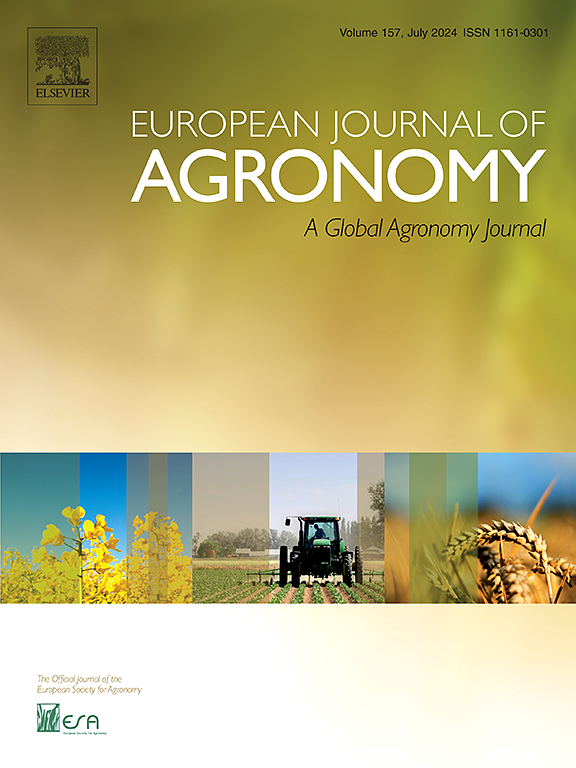玉米/花生条间作提高了产量稳定性和钾的利用效率
IF 5.5
1区 农林科学
Q1 AGRONOMY
引用次数: 0
摘要
间作制度通过资源互补性提高了产量的稳定性,提供了一种可持续的农业方法。钾(K)是植物生长的重要养分,对作物产量和稳定性有重要影响,但其在间作中的调节机制尚不清楚。本研究基于2022年至2024年的田间试验,评估了三种钾肥施用量(K0: 0 kg K₂O ha⁻¹,K1: 60 kg K₂O ha⁻¹,K2: 120 kg K₂O ha⁻¹)对玉米/花生单作(MS)和8:8条间作(IS)产量和稳定性的影响。结果表明,与ms相比,IS显著提高了玉米产量,减轻了花生产量损失,系统总产量提高了23.82 %,在不利气候条件下(土地等效比>;1). 施钾提高了玉米产量和稳定性,但施钾对IS的贡献率比ms低52.16 %。相关分析和偏最小二乘结构方程模型(PLS-SEM)显示,玉米产量与整个系统产量和稳定性之间存在很强的正相关关系。在IS中,以净多样性效应为主,K水平负向调节补偿效应。在K0条件下,作物补偿的增加显著提高了玉米的相对产量,保持了系统的稳定性。在K1和K2条件下,多样性效应和施钾共同促进IS产量,不同施钾水平间差异不显著。综上所述,玉米是is产量和稳定性的关键,而多样性效应增强了系统对钾水平的适应性和持续产量优势。本文章由计算机程序翻译,如有差异,请以英文原文为准。
Maize/peanut strip intercropping improves yield stability and potassium use efficiency
Intercropping systems enhance yield stability through resource complementarity, providing a sustainable agricultural approach. Potassium (K), a vital nutrient for plant growth, significantly influences crop yield and stability, although its regulatory mechanisms in intercropping remain underexplored. This study, based on field experiments from 2022 to 2024, assessed the impact of three K application rates (K0: 0 kg K₂O ha⁻¹, K1: 60 kg K₂O ha⁻¹, K2: 120 kg K₂O ha⁻¹) on yield and stability in maize/peanut monocrop (MS) and 8:8 strip intercropping (IS). Results indicated that IS significantly boosted maize yield while mitigating peanut yield loss, with a 23.82 % higher total system yield compared to MS. IS also demonstrated major yield stability under adverse climatic conditions (land equivalent ratio > 1). K application enhanced yield and stability, although the K contribution rate in IS was 52.16 % lower than in MS. Correlation and partial least squares structural equation modeling (PLS-SEM) analyses revealed a strong positive correlation between maize yield and overall system yield and stability. In IS, dominated by net diversity effects, K levels negatively regulated the compensation effect. Under K0, enhanced crop compensation significantly increased maize relative yield and maintained system stability. Under K1 and K2, IS yield was jointly promoted by diversity effects and K application, with no significant differences between K levels. In conclusion, maize is pivotal for IS yield and stability, while diversity effects enhance system adaptability to K levels and sustaining yield advantages.
求助全文
通过发布文献求助,成功后即可免费获取论文全文。
去求助
来源期刊

European Journal of Agronomy
农林科学-农艺学
CiteScore
8.30
自引率
7.70%
发文量
187
审稿时长
4.5 months
期刊介绍:
The European Journal of Agronomy, the official journal of the European Society for Agronomy, publishes original research papers reporting experimental and theoretical contributions to field-based agronomy and crop science. The journal will consider research at the field level for agricultural, horticultural and tree crops, that uses comprehensive and explanatory approaches. The EJA covers the following topics:
crop physiology
crop production and management including irrigation, fertilization and soil management
agroclimatology and modelling
plant-soil relationships
crop quality and post-harvest physiology
farming and cropping systems
agroecosystems and the environment
crop-weed interactions and management
organic farming
horticultural crops
papers from the European Society for Agronomy bi-annual meetings
In determining the suitability of submitted articles for publication, particular scrutiny is placed on the degree of novelty and significance of the research and the extent to which it adds to existing knowledge in agronomy.
 求助内容:
求助内容: 应助结果提醒方式:
应助结果提醒方式:


